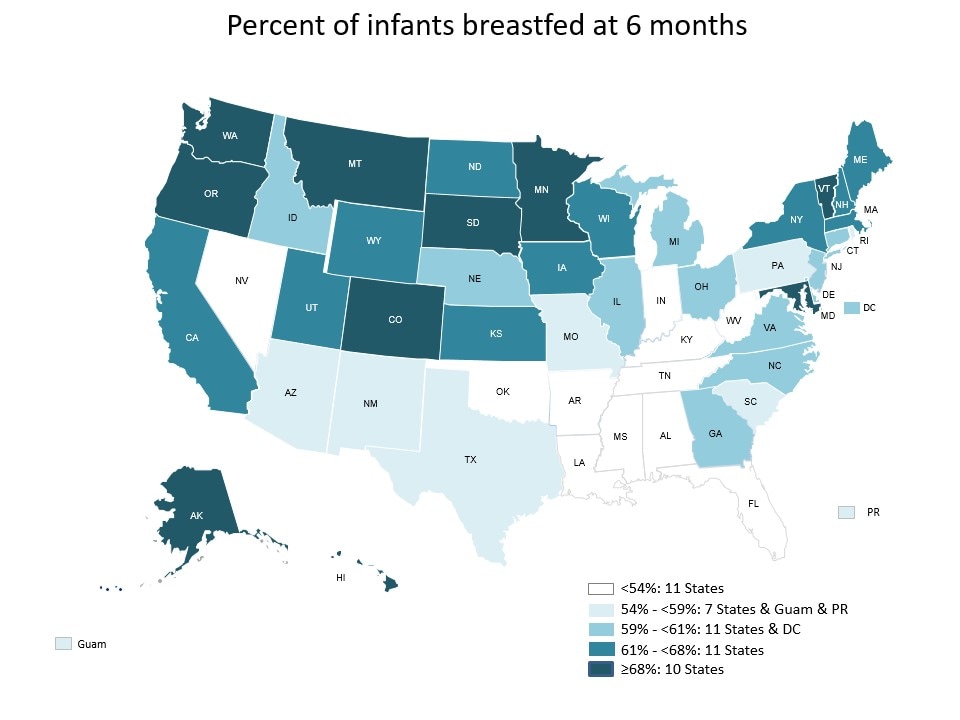At a glance

Overview
The U.S. Dietary Guidelines for Americans 2020-2025 recommend that mothers:
- Exclusively breastfeed their infants for about the first 6 months.
- Continue to breastfeed their infants while introducing appropriate complementary foods for 1 year or longer.
The American Academy of Pediatrics and the World Health Organization also recommend mothers:
- Exclusively breastfeed their infants for about the first 6 months.
- Continue to breastfeed their infants along with introducing appropriate complementary foods for up to 2 years of age or older.12
Most infants receive some breast milk. However, most mothers do not exclusively breastfeed their infants or continue to breastfeed them as long as recommended.
Healthy People 2030 breastfeeding objectives*
| Exclusively through 6 months. |
• Baseline - 24.9%† • Target - 42.4%* |
|---|---|
| At 1 year. |
• Baseline - 35.9%† • Target - 54.1%* |
*Healthy People 2030 Breastfeeding Objectives
†Baseline rates represent infants born in 2015, National Immunization Survey – Child.
Key breastfeeding indicators for infants born in 2021
Key breastfeeding indicators and current rates
| Ever.* | 84.1% |
|---|---|
| At 6 months.* | 59.8% |
| At 1 year.* | 39.5% |
| Exclusively through 3 months.* | 46.5% |
| Exclusively through 6 months.* | 27.2% |
| Receive formula supplementation within the first 2 days of life.* | 20.5% |
*Current rates represent infants born in 2021, National Immunization Survey – Child 2022–2023.
Rates of breastfeeding vary across states and regions
- Infants living in the Southeast United States are less likely to be breastfed at 6 months than infants living in other areas of the country (map below).3
- Infants in rural areas are less likely to ever breastfeed than infants living in urban areas.3
- For state-by-state breastfeeding rates, please visit the Breastfeeding Rates page. Historic data are also available in Nutrition, Physical Activity, and Obesity online Data, Trends, and Maps database.
Percentage of infants breastfed at 6 months

See data table: Rates of Any and Exclusive Breastfeeding by State among Children Born in 2021.
Breastfeeding disparities exist
- Fewer non-Hispanic Black infants (75.4%) are ever breastfed compared with Asian infants (92.7%), non-Hispanic White infants (86.2%) and Hispanic infants (83.4%).3
- Infants eligible for and receiving the Special Supplemental Nutrition Program for Women, Infants, and Children (WIC) are less likely to ever be breastfed (75.4%) than infants eligible, but not receiving WIC (84.6%), and infants ineligible for WIC (92.4%).3
- Younger mothers aged 20 to 29 years are less likely to ever breastfeed (80.0%) than mothers aged 30 years or older (86.1%).3
Why mothers stop breastfeeding early
Sixty percent of mothers do not breastfeed for as long as they intend.4 How long a mother breastfeeds her baby is influenced by many factors, including:
What you can do to support breastfeeding
State and local organizations can support breastfeeding by implementing organizational policies, systems, and environmental solutions. To learn more, visit:
What is being done to improve rates
Breastfeeding is important for the health of mothers and babies. CDC supports continuity of care in breastfeeding support through hospital initiatives, work site accommodation, and community support initiatives.
- American Academy of Pediatrics. Section on Breastfeeding; Policy Statement: Breastfeeding and the Use of Human Milk. Pediatrics. 2022; 150 (1): e2022057988. 10.1542/peds.2022-057988.
- World Health Organization. WHO Breastfeeding website. Accessed October 3, 2024.
- Centers for Disease Control and Prevention. National Immunization Survey-Child (NIS-Child) website. Accessed October 3, 2024.
- Odom EC, Li R, Scanlon KS, Perrine CG, Grummer-Strawn L. Reasons for earlier than desired cessation of breastfeeding. Pediatrics. 2013;131(3):e726–732.
- Sriraman NK, Kellams A. Breastfeeding: What are the barriers? Why women struggle to achieve their goals. J Womens Health (Larchmt). 2016;25(7):714–722.
- Feltner C, Weber RP, Stuebe A, Grodensky CA, Orr C, Viswanathan M. Breastfeeding Programs and Policies, Breastfeeding Uptake, and Maternal Health Outcomes in Developed Countries. Agency for Healthcare Research and Quality (US); July 2018.
